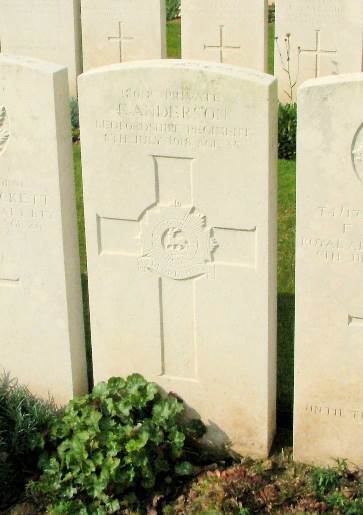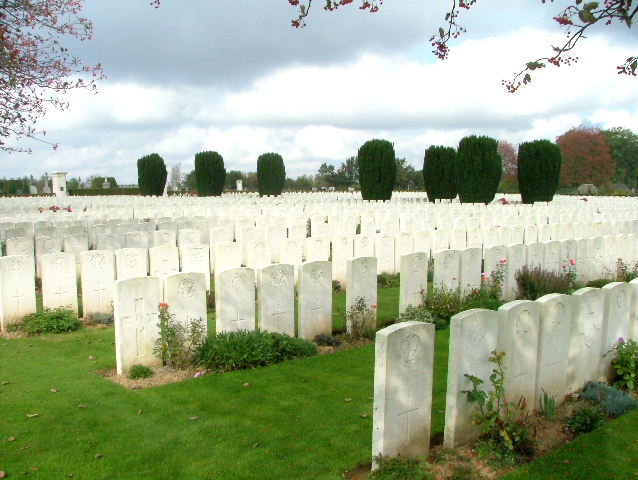Name
Fred Anderson
Conflict
First World War
Date of Death / Age
08/07/1918
35
Rank, Service Number & Service Details
Private
18618
Bedfordshire Regiment
8th Bn.
Awards: Service Medals/Honour Awards
British War and Victory medals
Cemetery/Memorial: Name/Reference/Country
AUBIGNY COMMUNAL CEMETERY EXTENSION
IV. J. 41.
France
Headstone Inscription
Not Researched
UK & Other Memorials
Pirton Village War Memorial,
St Mary’s Shrine, Pirton,
Methodist Chapel Plaque, Pirton,
Hitchin Town Memorial,
St Mary's Church Roll of Honour (Book), Hitchin,
Not on the Norton memorials
Wartime Service
Biography
Fred’s connection to Pirton began only a few years before the war and for most of his life he lived in Norton, Hertfordshire. His parents, John Hagger Anderson and Elizabeth (Fanny in 1881 census) (née Grummitt), were both born in Norton. They seem to have started their married life living there, in Elizabeth’s parents’ home on Wilbury Farm, with their first born, Martha. By 1891 John had risen from farm labourer to bailiff on Wilbury Farm and was still living there, but now in their own home. Their family had grown and now included Fred, aged eight and born around 1893 and Minnie aged three.
In the 1901 census Fred was eighteen and was boarding with the Hooper family in 9 Lordship Cottages, Willian, while earning his living as an agricultural worker. By 1911 he was married to Lilian Lizzie, they had a young daughter Winifred and were living in one of the Highdown Cottages, Pirton. Fred’s service records confirm that they married on December 23rd 1906 and his wife’s maiden name was Worbey. Interestingly, a family with surname Worbey lived at number 11 Lordship Cottages, when Fred was lodging in Willian. Although there was no Lilian present in 1901, a look at the 1891 census confirms that one of the daughters was called Lilian and so it seems they met in Willian.
The October issue of the Parish Magazine in 1911 confirms he was working for Thomas Franklin on Highdown Farm. It reports the harvest supper, chaired by Mr Franklin and attended by his employees. They included Harry Crawley, who also served and died. It seems that a good time was had by all, with ‘loyal toasts’, ‘old-fashioned English songs’ and ‘The health of the Chairman . . . . . most heartily drunk by all.’
In 1914 he was the stockman on Highdown Farm and although a family man, like many others he felt that it was his duty to serve. On January 2nd 1915 he travelled to Hitchin and enlisted in the Bedfordshire Regiment as Private 18618, for the duration of the war.
He went for training and remained in England until May 18th 1916 when he embarked for France. His Battalion, the 8th Bedfords, was already in Belgium and having a tough time fighting in the defence of Ypres. Their war diary records the losses for April as 54 men killed, 3 wounded, 95 missing believed killed, 91 sick to hospital and 20 evacuated to base. Fred was probably one of the thirty-four other ranks that joined the Battalion in Belgium on May 24th - not nearly enough to replace the losses. He probably found himself in a working party almost immediately, sandbagging dugouts and generally trying to improve conditions; 310 men worked on the night of the 25th, 300 on the 26th and 27th and 400 on the 28th. On the 29th they moved back into the front line, relieving the King’s Shropshire Light Infantry, and remained there until the night of June 5th. The casualties were averaging one or two a day. They rested until the 11th, then returned to the trenches the next day and saw the terrifying continuous artillery bombardment on the nearby Canadians, before they attacked to recapture earlier lost ground. This action appears to have been a complete success with no casualties and the capture of ‘about one hundred prisoners’ – a rare thing at this stage of the war. They stayed in the trenches until the 17th and, although the enemy was sometimes described as ‘quiet’ or ‘non-aggressive’, that must be judged against their experience of ‘normality’ and during this period they experienced artillery bombardments and machine gun fire. To the soldiers’ relief the latter half of June and the first half of July was spent resting and training, although large working parties were still sent out at night, which was a very dangerous duty.
In early August they moved to France. Their first stop was near Doullens, then Pichevillers and Louvencourt. Much of the movement, if not all, was by route march. They trained in bayonet fighting and attacking trenches until the middle of August, when they moved into the trenches around Beaumont Hamel and into the Battle of the Somme (1916). The Germans used heavy trench mortars on them and the British replied with artillery. The next day the enemy tried shrapnel and trench mortars. On the 18th the Bedfordshires carried out a dummy raid ‘to worry the enemy’. The Germans retaliated ‘slightly damaging our trenches in places.’
None of this seems out of the ordinary for the time; casualties were relatively low and it is easy to make light of the experience, as the war diaries always seem to, but it is difficult to understand what individual soldiers may have seen or experienced. Most if not all of these men would have seen comrades fall, either badly injured or killed by shell, sniper or in raids or attacks.
The Battalion diary gives the Field State of the 8th Bedfords for the month of August. ‘Killed 8 Wounded 27 Sick to Hospital 72 Sick from Hospital 17 Evacuated from F.A.(Field Ambulance) 46 “A” Coy Strength 16 officers 202 other ranks “B” Coy Strength 6 officers 214 other ranks “C” Coy Strength 8 officers 230 other ranks “D” Coy Strength 8 officers 212 other ranks - Total 38 officers 858 other ranks.’
Fred was one of those listed as ‘sick to hospital’ and the doctors decided that he was ill enough to be returned to England and so he left France on September 5th 1916. He had been in France for 110 days. His service records show that he was admitted to Norfolk War Hospital at Thorpe, Norwich with Myalgia. This is muscle pain and can be caused by overstraining the muscle, injury, allergic reaction, or disease, but this hospital had been a mental asylum, so it is possible that his sickness was actually related to shellshock. He left hospital on September 16th and went to RGH Downham – the writing is unclear - perhaps another hospital, where he stayed until October 12th.
Unfortunately, but understandable considering their age, some parts of his service records are difficult to read. They show that he was transferred on December 14th to the 2/4th Battalion of the Suffolk or Norfolk Regiment. Then, on March 14th 1917, to the 3rd Infantry Company, Northamptonshire Regiment and then to the 141st Company of the Labour Corps on May 14th 1917 and they left Folkestone for Boulogne on the 23rd. His transfer to the Labour Corps suggests that Fred had not recovered sufficiently to be regarded as fighting fit.
The Labour Corps was formed to solve a problem. The manual labour required to support the fighting troops in the building and maintaining roads, railways and other infrastructure was poorly organised and often diverted fighting men from the front line. So in January 1917 the Labour Corps was formed. It took men who were not classed as ‘A1’. They could be men who enlisted and were not of the highest physical fitness or men like Fred, who through injury or illness were no longer considered fit enough for the front line. That did not mean that they were out of danger; on the contrary they often worked for prolonged periods within the range of enemy guns.
It is often more difficult to establish the movements of a Labour Corps than a Battalion in the front line, simply because there seem to be no war diaries for the former. A new reference book ‘No Labour, No Battle’ by J Starling and Ivor Lee (*1), is dedicated to the men who provided a labour service for the war. Their work is often misunderstood and its value underestimated and the book seeks to correct this. It also provides a few clues to Fred’s service. His number, 84038, confirms the approximate date of his transfer and that his Company was formed out of the 3rd Infantry Company, Northamptonshire Regiment. Fred’s Labour Company, like the others, consisted of about 500 men, their work included digging in communication cables, mending breaks caused by shelling and making and maintaining forward roads. The range of these locations was often known to the enemy artillery and the Labour Corps suffered accordingly.
Whether he had fully recovered from his earlier illness is not known, but in August 1917 he became ill again and was hospitalised again, this time with influenza. He moved between several hospitals, before being discharged back to his unit in the field on September 8th and so he continued with his work duties for the next few months.
The only specific information for the 141st that has been found to date is that at the launch of the German Spring Offensive on March 21st 1918, they were at an ammunition dump at Flavy-Le-Martel and they were not withdrawn until it was shelled and under machine gun fire.
His poor health continued and was hospitalised again on June 29th 1918. His service record shows that he died of broncho-pneumonia(*2) on July 8th 1918 aged thirty-five.
He was buried in Aubigny Communal Cemetery Extension, which is an extension to the village cemetery and contains 2,771 Commonwealth burials of the First World War. Many of those that died were treated in the 42nd Casualty Clearing Station, so it is probable that he was taken there before he died.
The communal cemetery is quite large and sits on a raised plateau. To find Fred you must enter the raised cemetery by climbing a small set of stone steps and pass through the village cemetery to where these men lie.
Aubigny-en-Artois is a village approximately nine miles north-west of Arras on the road to St. Pol. The village cemetery lies to the south, on a road leading from the centre of the village, and the Extension lies behind it.
His headstone does not read Labour Corps, but Bedfordshire Regiment, his original Regiment, which apparently was the normal practice for men who died while serving in the Labour Corps, but who had first served in another Regiment.
By September 1918 his widow Lilian had moved to Walnut Tree Cottage, Fishponds Road, Hitchin, which is where his effects were delivered; a disc, two badges, a photograph, his wallet, a watch and chain and a few buttons – not much to remember him by. She later moved to 5 Periwinkle Lane, Hitchin.
(*1) Published by Spellmount, ISBN 978-0-7524-4975-3
(*2) Pneumonia is an inflammation of the lung tissue usually caused by infection. Bronchitis is an inflammation or infection of the large airways. Together they are known as broncho-pneumonia.
Additional Information
Text from the book: The Pride of Pirton
Acknowledgments
The Pride of Pirton book – www.pirton.org.uk/prideofpirton Chris Ryan / Tony French / Jonty Wild



